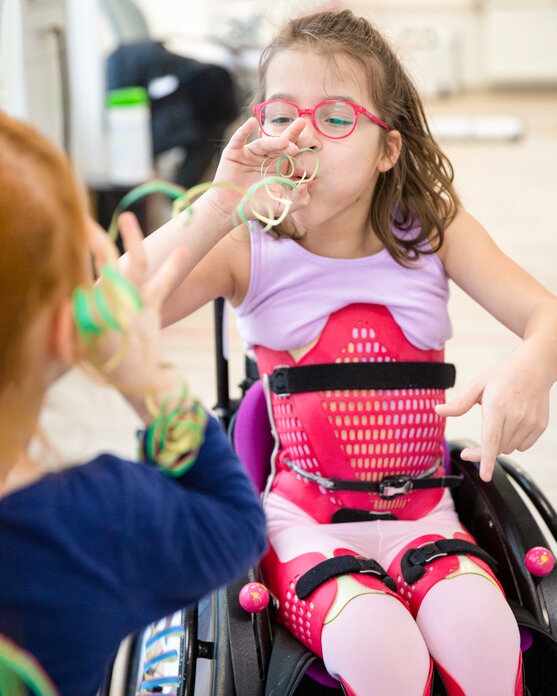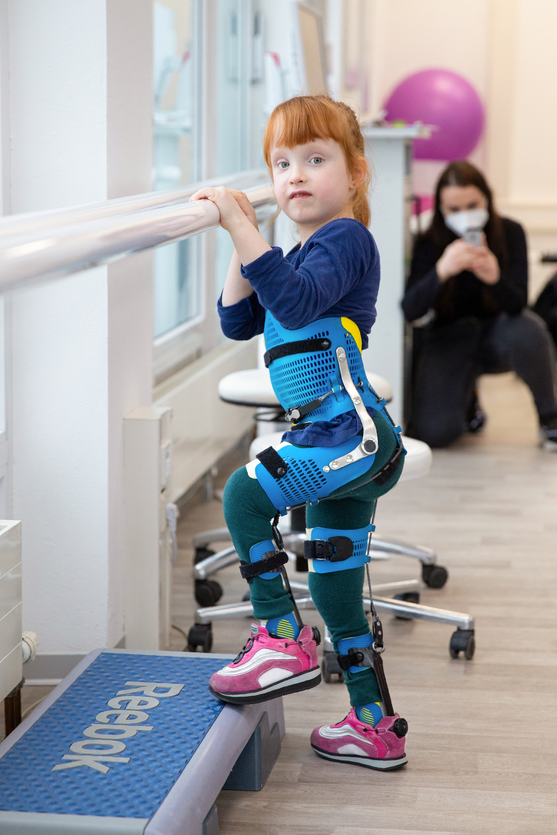
PowerHip® works using one’s own power supplied from the legs. This is transferred to the hips.
We train you in the daily use of your PowerHip® orthosis.
Make an appointment over the phone or send us a message!

Mobile through power transmission
New orthosis for spina bifida patients
The PowerHip® self-powered orthosis was primarily developed for children with spina bifida. The device, which is individually adapted to the patient’s body and created using 3D printing, transfers the force from the mostly strong knees of the child to the weak hip. This means that the orthosis actively stretches the hips – using its own leg strength!
Many children with spina bifida can move better because of the PowerHip®, and are more mobile overall.

Let yourself be inspired! We accompany many interesting patients during their Pohlig appointment and give you personal insights.

For those who want to delve even deeper into the matter, we have a suitable video for almost every supply area.

Take a look behind the scenes at Pohlig and find out about diagnoses and our innovative aid solutions!

Amaya actually needs a wheelchair to get around. She is partially paralysed due to her congenital spina bifida (myelomeningocele). With the 3D printed PowerHip® orthosis, Amaya can walk on crutches. She diligently practices putting one step in front of the other with her physiotherapist.
When muscle strength is lacking
Symptoms of spina bifida
Patients with spina bifida (also MMC or open back) often suffer from limitations of their musculoskeletal system. It is not uncommon for scoliosis, joint contractures (especially on the lower extremities) and foot malpositions to occur. Hip dysplasias (false positioning of the hip head in the acetabulum) or even dislocations of the hips (hip luxation) are observed relatively often. These symptoms primarily affect spina bifida patients in terms of their mobility and independence.
The concrete effects of spina bifida on the joints – and in particular on the hips – depend on the level of paralysis. The higher the opening on the child’s back, the more severe the symptoms of paralysis.
Consequences of paralysis are in turn malpositions and muscle imbalances in the hip, knee and ankle joints. As a result, spina bifida patients often experience reduced or absent muscle activity in the hip.


One orthosis, many benefits
PowerHip® makes you strong!
For a long time, children with MMC who were unable to stand up and walk independently were fitted with a so-called pelvic orthosis. However, younger patients in particular often complained about the heavy weight of the orthosis, which significantly limited their newly gained mobility. In addition, many parents reported that putting on and taking off the pelvic orthosis was time-consuming.
The idea for the 3D-printed intrinsic strength orthosis arose during a consultation attended by Dr. med. Chakravarthy U Dussa (head physician in pediatric orthopedics) and a Pohlig employee at the Aschau treatment center. The doctor and orthopedic technician together considered whether a lighter orthosis could be designed that would give the patient even more freedom of movement. According to Dr. med. Dussa, close cooperation between the treating physician and the technician is indispensable for the development of new orthoses. Only through a lively exchange can ideas be created and set in motion in the first place.
After the initial spark, numerous prototypes of the PowerHip® self-weighting orthosis were produced in the development department of Pohlig, which were intensively tested with the help of voluntary patients. The feedback from the children and their parents was extremely positive. Almost all MMC patients showed a clear improvement of the gait pattern.
In addition, many parents praised the narrow shape of the PowerHip® orthosis, as it was now finally possible to sit in an (active) wheelchair even with the orthosis. The lightweight, air-permeable and flexible material, which gives the children better freedom of movement with the orthosis, was particularly positively highlighted. The time required to put on and take off the orthosis has also been significantly reduced - the PowerHip® is ready for use in just a few steps!
Incidentally, the intrinsic strength orthosis is also ideal for training and therapy, as it helps to train strength and strengthen muscle areas. However, this innovative aid is not suitable for every spina bifida patient, but only for children who meet certain physical requirements. In order to be able to use the intrinsic strength orthosis, MMC patients, as the name suggests, need a certain amount of strength in their own legs. Children, therefore, whose paralysis level is relatively low (below L4) are generally suitable for wearing the PowerHip® orthosis. A second prerequisite is that the patients have no or only minimal hip flexion contracture (below 10-15 degrees).
All the advantages of the PowerHip® orthosis at a glance:
- improvement of the gait pattern
- extremely light and flexible materials thanks to the 3D printing process
- air permeability
- possibility to sit with orthosis in wheelchair due to slim design
- division of the PowerHip® orthosis into individual segments: the lower leg orthosis can be worn independently of the hip or pelvis section
- use of the PowerHip® orthosis for training and therapy, as it strengthens different muscle areas.


